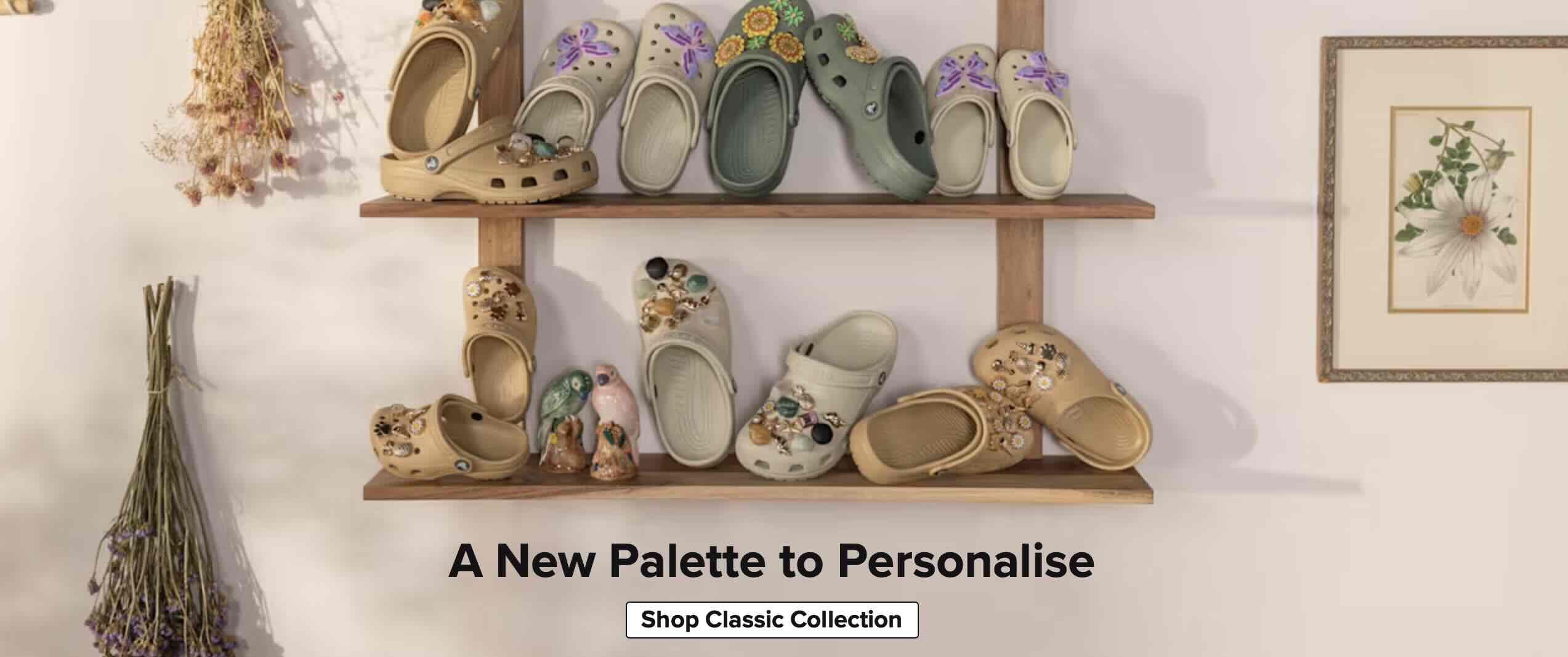The dramatic turnaround of the Crocs brand is one of the most impressive brand revitalisation example I’ve come across. The company was on the verge of bankruptcy back in 2009, having lost $185m the year before (1). Revenue then stagnated during the 2010s, with the brand being seen as selling ugly, unfashionable shoes. “If you Googled ‘Crocs’ in 2016, there’s a high chance you were looking to have a laugh at the brand. Why? Because at the time, the brand’s footwear was mocked mercilessly as the height of fashion disasters,” as Marketing Week explains (2).
A new brand strategy was implemented in 2017, with sales growing steadily before accelerating. By 2023, revenue of $3billion was three times the pre-relaunch level (see below). We will explore how the Crocs brand got its bite back in two posts. The exciting, digitally-led brand marketing of Crocs gets a lot of coverage and we will look at that next week. But we start in this post with part of the story that is less talked about: the power of focus. I draw on insights into how Crocs focused its investment of time, talent and money, drawing on a keynote at Madfest by Senior Marketing Director Yann Le Bozec (3).
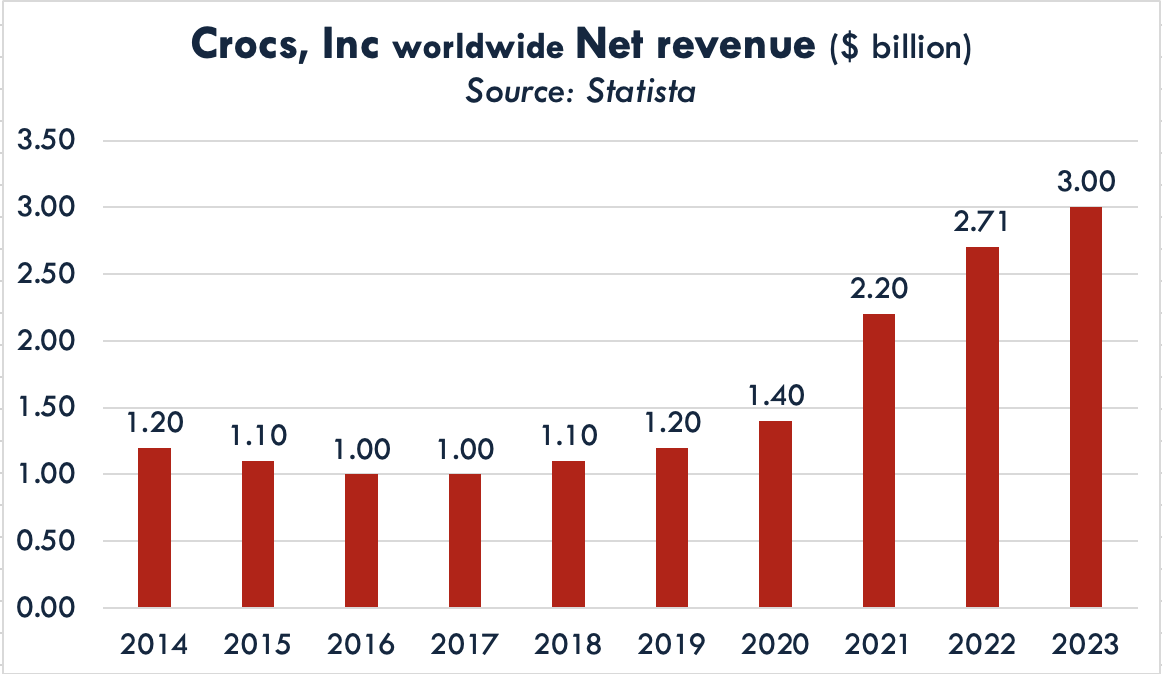
1. PRODUCT focus
By the early 2010s, Crocs had diversified beyond the original “clog” shoe that made the brand famous. The brand offered “230 different styles, all based on its comfortable Croslite material but with variations from sandals to walking shoes, boots and even high heels,” according to a Guardian article (4). You can see a snapshot of the extended product offer below (5). The core clog product generated a mere 16% of Crocs’ sales.
This “overdiversification” of the product offer, as the company called it, diluted the brand’s equity. The newer shoes had a link to the core via the rubbery material. However, they lacked the distinctive visual identity of the clog, recognised by 90% of people as Yann explained in his keynote. The new shoes also lacked the holes in the clogs that allow personalisation via shoe charms called “Jibbitz”. An additional problem with the wide range of products was creating complexity for manufacturing and the supply chain.
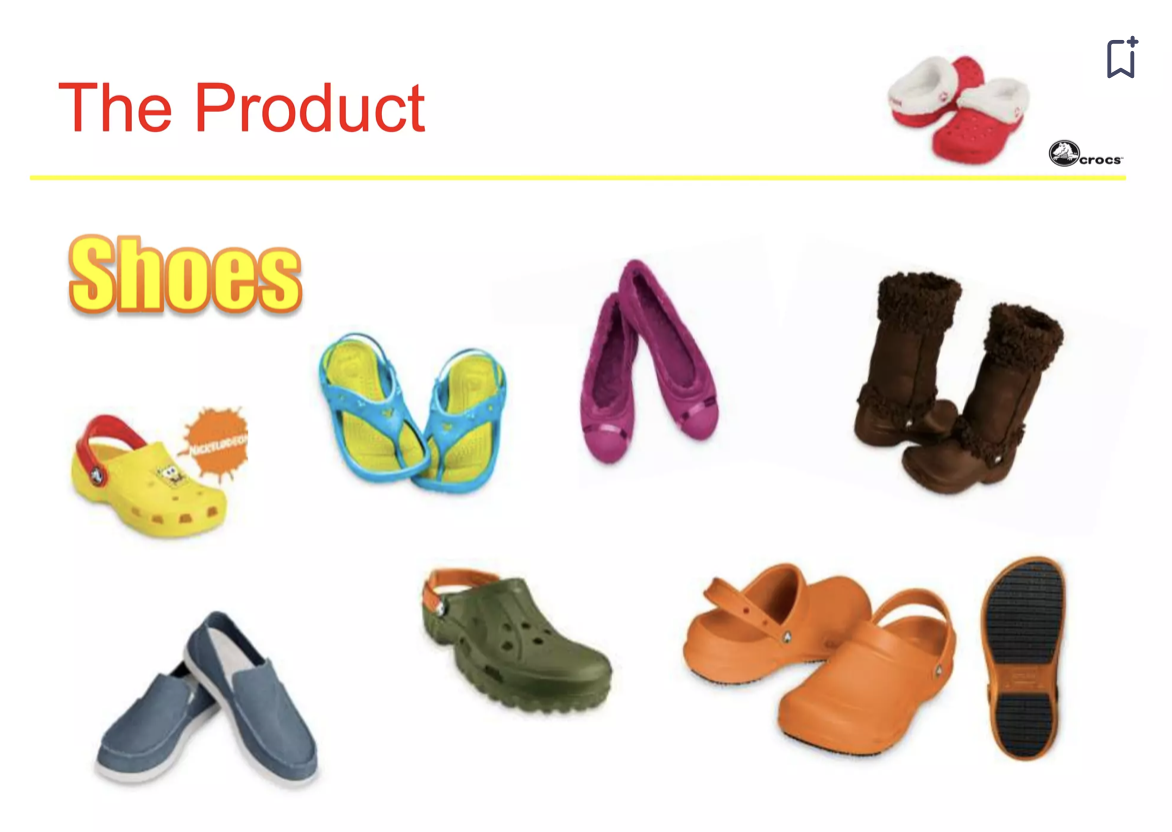
A key pillar of the 2017 re-launch strategy was to refocus on the core product. The company “recognised the potential of our iconic clog and focused on the sandal and personalisation,” according to a company video shared by Yann (3). The focus was ruthless, with the company cutting half the SKUs they were selling.
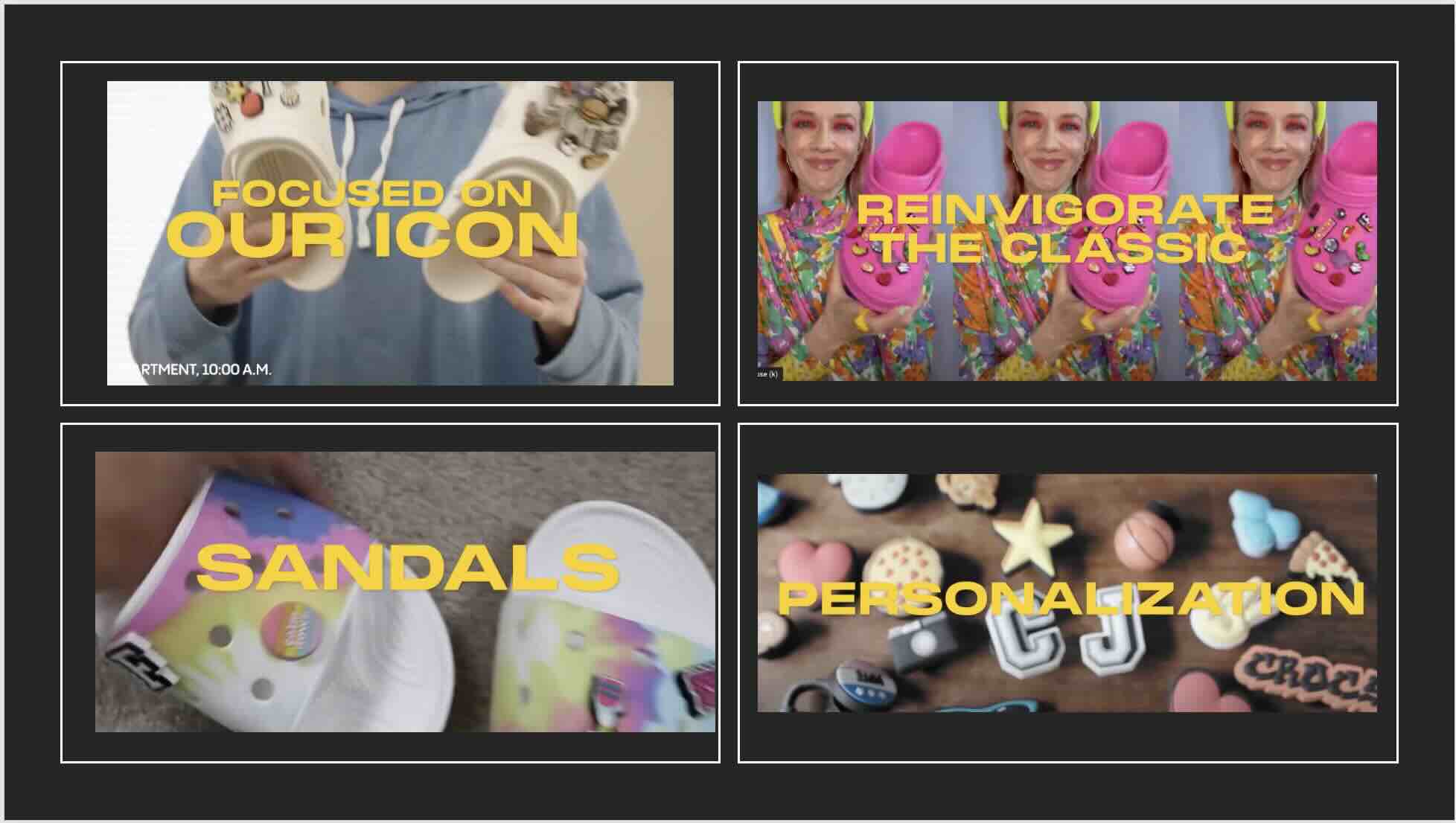
2. MARKET Focus
The second key area of focus was in terms of geography. Investment was focused on five key markets with the strongest growth potential: US, China, Korea, Japan and Germany. “Sub-scale” markets lacking the size to support a full team were transferred to distributors.
3. STORE focus
The store footprint of the brand was also dramatically reduced, from 600+ stores in 2013 to 350 today. This had potential to deliver a double effect. First, the focus would allow the brand to concentrate efforts on stores with the strongest sales performance. Second, there was the opportunity to focus on stores in the right areas to deliver an aspirational image for the brand. A big push was also made to drive sales through digital channels including direct to consumer (D2C). By 2021, digital channels accounted for c. 40% of the brand’s revenues.
4. MARKETING focus
A global brand playbook was created, to drive more efficient and effective marketing across key markets. In addition, channel focus led the brand to concentrate efforts on digital marketing and collaborations, with brands, celebrities and influencers (more on this next week). These changes, along with a more focused approach to markets and stores detailed above, drove an $80million reduction in expenses for SG&A (Selling, general & admin).
Another significant change was to focus on design and creative marketing, with production outsourced.
The more focused business model described so far is reflected in an industry-leading profit margin of 36% for the Crocs brand (5), as shown below. This is quite some long-term transformation for a company that was once on the brink of bankruptcy.

5. CORE CONSUMER focus
A final key area of focus was in terms of core consumer target. Croc’s objective is rightly to reach as many consumers as possible. However, having a clear core target helps create the distinctive marketing needed to drive awareness and consideration, as I posted on here.
Crocs identified “Explorers” as the core target to focus on when creating distinctive marketing (3). This group were younger consumers who were early into trends. They wanted comfort but also to express theire self-confidence (see below). Creating a mix that this group loved could also appeal to a secondary, probably bigger segment of “Feel Good” older consumers. This group were looking for comfort and versatility from a shoe that could be worn on different occasions.
The trick with this approach, that we use on brandgym brand positioning projects, is to identify the “sweetspot” of shared needs that unify the two segments. For Crocs, this is the need for comfort and self-expression. By focusing on the sweetspot, you can create a unified, single minded brand positioning and mix.
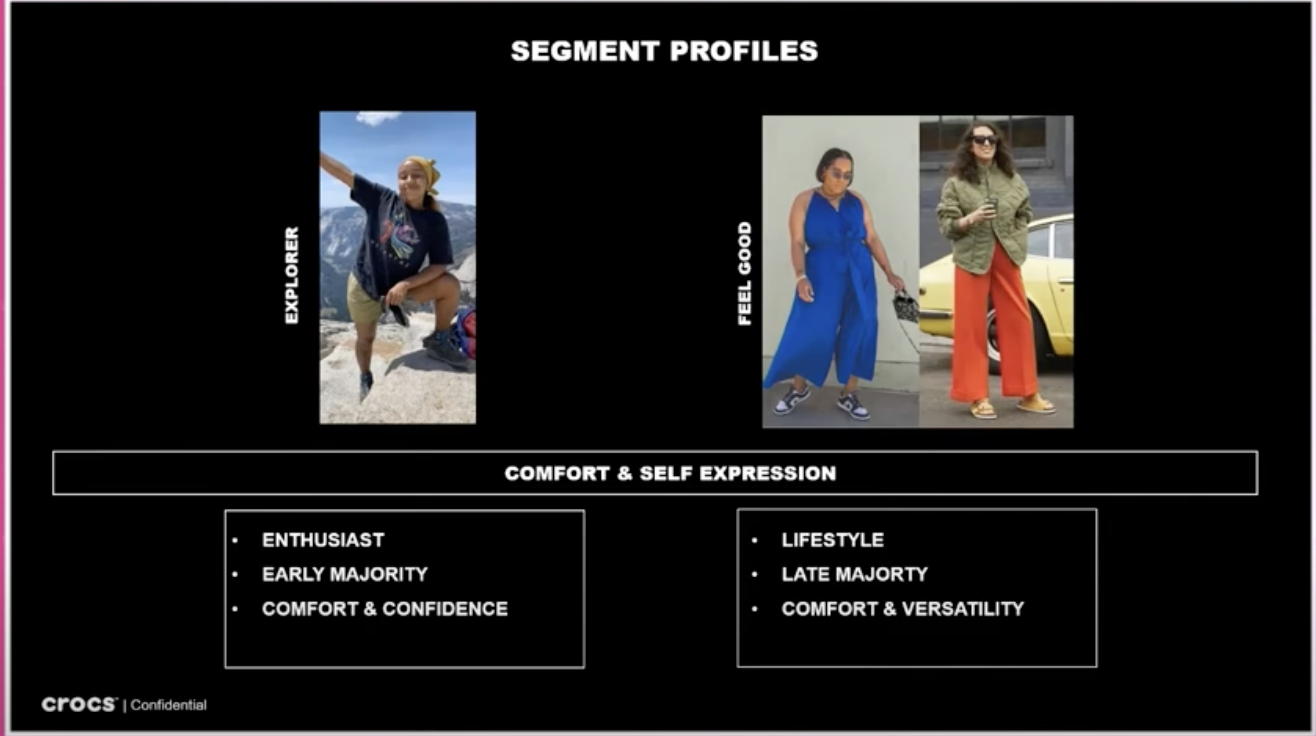
6. WATCHOUT: brand portfolio focus
One area where Crocs seem to be less disciplined is brand portfolio focus. In 2021, the company acquired a second footwear brand, Heydude, for $2billion and $450million in Crocs shares. Investor concern over this brand portfolio diversification is one key factor in the bumpy ride the share price has had in the last three years. After a vertiginous rise to a peak in 2021, the shares lost 75% of their value before recovering some of these losses*.

*I’d still be delighted if I’d bought Crocs shares back in 2017 for <$8: they’re worth 19x that today!
HeyDude seems to lack the power of the Crocs product proposition. “They’re not all that comfortable and are also on the wrong side of being ugly, and therefore have ended up missing the mark,” reported Forbes (6). As a result, Heydude dragging down the company’s overall growth. “The company signaled more challenges around its HeyDude brand with its latest 2023 revenue projection of 4%-6% growth, down from its estimate for 14%-18% growth over the summer,” reported Marketwatch late last year (7). And the company’s final 2023 results confirmed Hetydude’s poor performance: Crocs Brand revenues increased 13.3%, whereas Heydude’s contracted by -3.7% (8). The concern here is that time, talent and energy from the top team down will be taken away from the Crocs core brand to try and sort out the problem child brand that is Heydude.

In conclusion, this first, less well known part of the Crocs brand revitalisation story shows the power of focus across marketing, product, distribution and geography. Look out next week for part two on brand positioning and marketing.
SOURCES
(1) Guardian article including 2009 results
(2) Marketing Week on Crocs in 2016
(3) Madfest keynote by Yann Le Bozec
(4) Guardian 2010 brand stretch
(8) 2023 results
